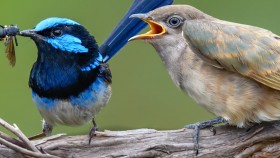A cuckoo finch in sheep's clothing
Cuckoo finches in Africa have adopted a unique disguise to help them lay their eggs in other birds’ nests, biologists have found.
The cuckoo finch in Zambia has evolved to be almost indistinguishable from common and harmless female weaver birds, such as the southern red bishop, said Dr William Feeney, from The Australian National University (ANU).
“The cuckoo finch is so similar to the innocent bishops, that the target of the trickery, the tawny-flanked prinia, cannot tell them apart,” said Dr Feeney, who did his PhD at the ANU Research School of Biology before taking a position at the University of Cambridge, United Kingdom.
“The cuckoo finch looks a lot more similar to the bishop than its nearest relatives, the Vidua finches, suggesting that it has evolved to be able to hang around prinia nests without arousing suspicion,” he said.
Cuckoo finches, like the iconic cuckoos, are brood parasites who lay their eggs in the nests of other birds, to deceive them into raising the parasitic young as their own.
Brood parasites use a range of methods to deceive their hosts, a brood parasite is costly and hosts defend themselves against the deception.
However, Dr Feeney’s research is the first to find that an adult brood parasite has evolved to look harmless in an attempt to fool their host.
“This shows that brood parasites use this kind of wolf in sheep’s clothing disguise in all stages of their life cycle: as eggs, chicks, fledglings, and we now know, as adults,” Dr Feeney said.
However the prinia hosts are getting wise to the attempted deception, said Professor Naomi Langmore, who was Dr Feeney’s PhD supervisor at the ANU Research School of Biology.
“The prinias have learned to react aggressively towards the innocent female bishops, which look like female cuckoo finches,” she said.
“They reject foreign eggs from their nest at a higher rate after they have seen either a female cuckoo finch or a female bishop.
“But they do not act the same way if they have seen males of either species, which look quite different.”
The study is published in Proceedings of the Royal Society B.









